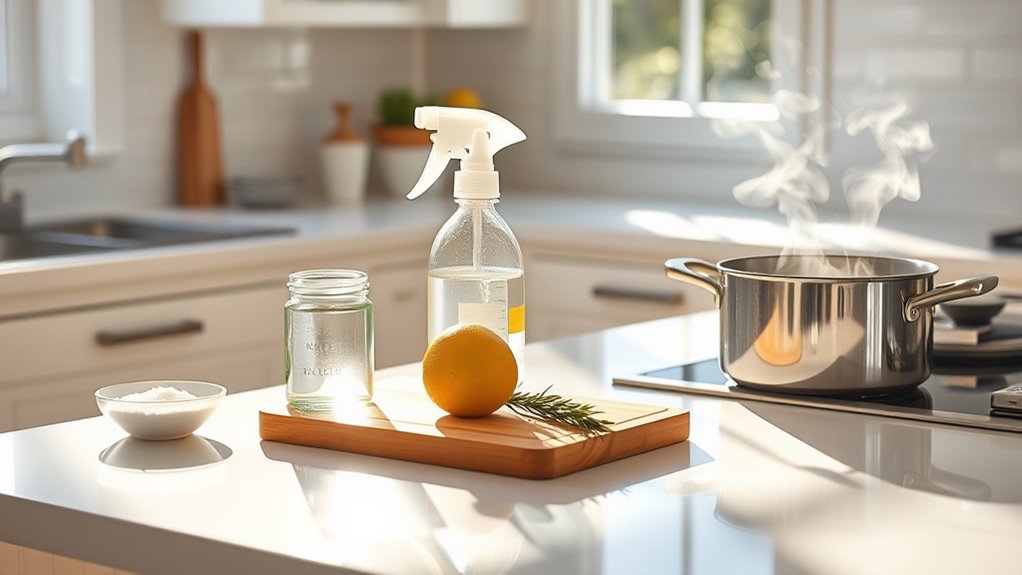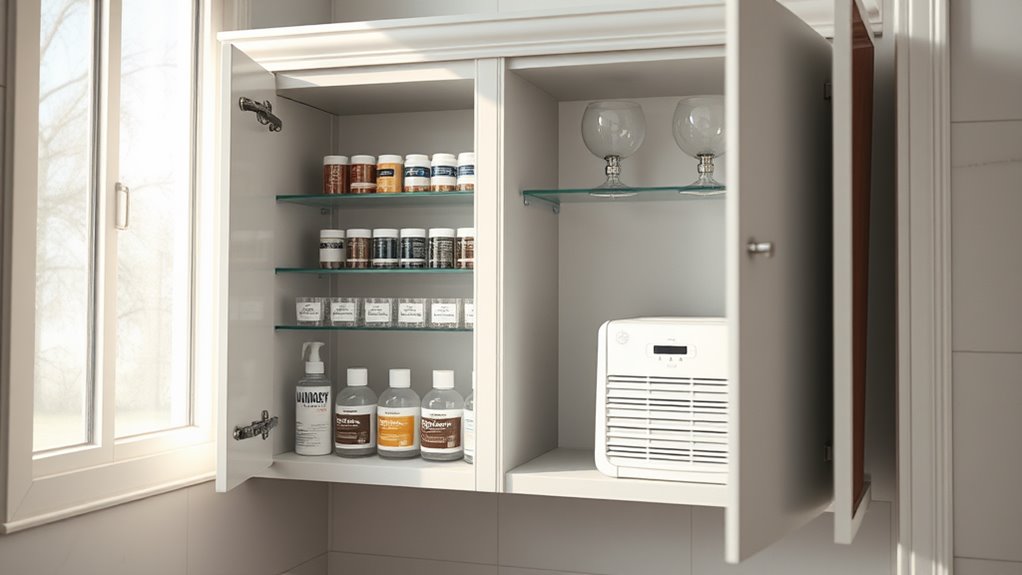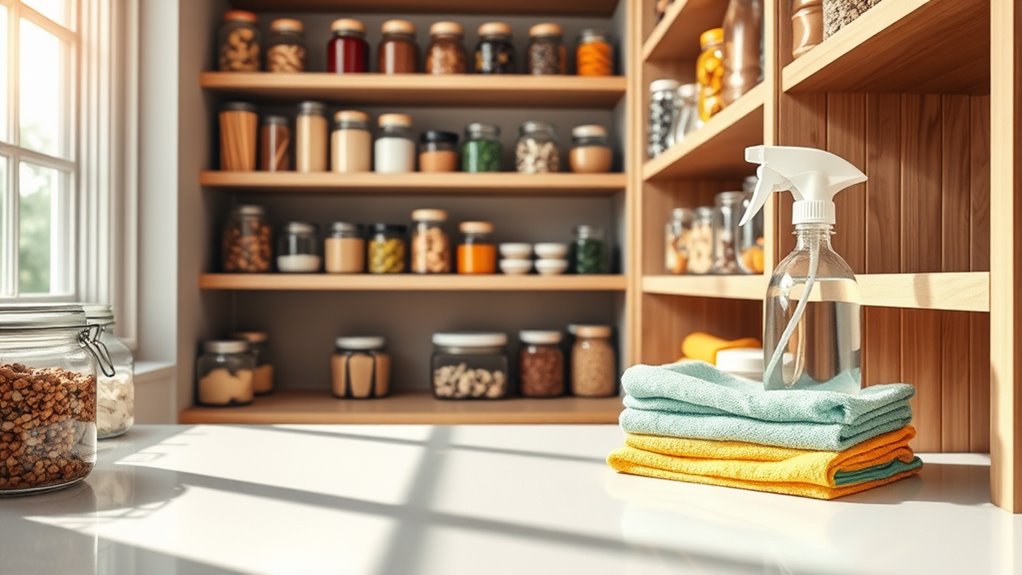My Favorite Way to Disinfect a Kitchen Without Harsh Products
If you want to disinfect your kitchen without harsh products, try using a mix of white vinegar and baking soda. Vinegar acts as a powerful disinfectant, while baking soda scrubs without scratching surfaces. Just combine equal parts of vinegar and water in a spray bottle, then apply it to surfaces. Wipe down after it sits for a few minutes. This method’s budget-friendly and safe for kids and pets. There are plenty of other effective tips to explore next!
Key Takeaways
- Use a vinegar and water solution as an all-purpose cleaner to effectively disinfect surfaces without toxic chemicals.
- Combine baking soda and water to create a gentle scrubbing paste for tough stains and odors.
- Incorporate essential oils like tea tree or lavender for added antibacterial properties and pleasant scents.
- Regularly sanitize sponges and cloths with a vinegar solution to prevent germ buildup in your kitchen.
- Maintain a clean environment by promptly cleaning spills and regularly emptying trash to minimize contamination.
The Benefits of Natural Disinfectants
When you choose natural disinfectants, you’re not just making a healthier choice for your kitchen; you’re also protecting the environment. These products provide effective, gentle disinfecting without the harsh chemicals found in traditional cleaners. By opting for natural alternatives, you minimize your exposure to toxic substances, safeguarding not just your health but that of your family too. Many of these solutions can be easily made at home using common household ingredients, allowing you to customize your cleaning routine. Additionally, eco-friendly bathroom cleaners can inspire you to create a holistic cleaning approach throughout your home. Natural disinfectants often harness the power of essential oils and plant-based ingredients, delivering powerful antimicrobial properties while being biodegradable. Using vinegar and hydrogen peroxide as disinfectants, for example, can enhance the effectiveness of your cleaning routine. Eco-friendly cleaning solutions mean you’re contributing to a cleaner planet as well. Plus, you’ll find that many natural options possess pleasant scents, enhancing your kitchen’s atmosphere. Using natural methods to sanitize your kitchen countertops can further improve your overall cleaning strategy. Embracing these gentle yet effective solutions will elevate your cleaning routine and promote a sustainable lifestyle.
Essential Ingredients for Homemade Cleaners
Creating homemade cleaners is easier than you might think, and just a few essential ingredients can make a world of difference.
First, white vinegar is a powerful disinfectant and deodorizer that tackles bacteria and odors effectively. Additionally, mixing it with water in a mixing ratio of 1:1 creates an effective floor cleaner. When combined with citrus peels, the cleaning power is enhanced, leaving surfaces with a fresh scent. Vinegar’s effectiveness is well-documented as an affordable cleaning solution that can replace many commercial products. It’s also important to note that vinegar can dissolve mineral deposits, which is incredibly beneficial for cleaning appliances.
Next, baking soda acts as a gentle abrasive, perfect for scrubbing away grime without scratching surfaces.
Combine these with essential oils like tea tree or lavender for added antibacterial properties and a pleasant scent. Castile soap is another versatile ingredient that can emulsify grease while being gentle on your skin.
Finally, hydrogen peroxide serves as a strong disinfectant, perfect for sanitizing surfaces. Additionally, these ingredients are eco-friendly alternatives that help you maintain a clean kitchen while avoiding harsh chemicals.
Step-by-Step Guide to Disinfecting Surfaces
When you’re ready to disinfect your kitchen surfaces, having the right cleaning supplies is key. You’ll want to use effective techniques to guarantee every area is sanitized safely. Additionally, using natural ingredients like vinegar can enhance your sanitization process while ensuring a safe environment. One highly effective method is using steam cleaning to eliminate bacteria without the use of harsh chemicals. Furthermore, using eco-friendly alternatives can contribute to a healthier home environment while maintaining cleanliness. For example, incorporating baking soda can help absorb odors and provide additional scrubbing power. Let’s break down the steps to help you apply these methods effectively. Incorporating DIY cleaners can provide a safe and effective way to maintain a clean kitchen without relying on commercial products.
Essential Cleaning Supplies
To effectively disinfect your kitchen surfaces, you’ll need a few essential cleaning supplies that are both safe and effective.
Gathering the right tools guarantees you can tackle any mess with confidence and efficiency. Here’s what you’ll want to have on hand:
- White vinegar: A natural disinfectant that cuts through grime.
- Baking soda: Perfect for scrubbing and deodorizing surfaces.
- Lemon juice: Its acidity helps in breaking down tough stains.
- Castile soap: A gentle yet powerful cleaner for various surfaces.
- Reusable microfiber cloths: Ideal for wiping down and trapping dirt.
With these supplies, you’re well-equipped to maintain a clean and healthy kitchen environment without relying on harsh chemicals.
Effective Disinfecting Techniques
With your cleaning supplies gathered, you’re ready to tackle the disinfecting process. Start by removing any debris from surfaces, ensuring you’ve got a clean slate. Next, apply your chosen natural disinfectant—like vinegar or a baking soda solution—liberally on the surfaces. Allow it to sit for at least 10 minutes to maximize effectiveness.
| Surface Type | Disinfectant Type | Recommended Time |
|---|---|---|
| Countertops | Vinegar | 10 minutes |
| Cutting Boards | Baking Soda | 15 minutes |
| Appliances | Hydrogen Peroxide | 5 minutes |
| Sinks | Dish Soap Mix | 7 minutes |
| Floors | Vinegar Solution | 10 minutes |
Finally, wipe surfaces down with a clean cloth, and let air dry for best results.
Safe Surface Application
As you prepare to disinfect your kitchen surfaces, it’s essential to ascertain safety and effectiveness by following a structured approach.
Start by gathering your materials and ensuring you understand the surfaces you’re working with. Here’s how to proceed:
-
Clear the area of all items, including appliances and utensils.
-
Wipe down surfaces with a damp cloth to remove any visible debris.
-
Apply your natural disinfectant evenly, focusing on high-touch areas.
-
Allow the solution to sit for the recommended time to guarantee efficacy.
-
Rinse surfaces with clean water if necessary, then dry with a clean cloth.
Effective Recipes for Natural Cleaning Solutions
When it comes to natural cleaning solutions, vinegar and baking soda are your best friends.
These common household ingredients pack a powerful punch against grime and bacteria.
Let’s explore some simple recipes that can transform your kitchen into a sparkling clean space.
Vinegar-Based Cleaning Solutions
If you’re looking for an effective yet natural way to clean your kitchen, vinegar-based cleaning solutions are a fantastic option.
These solutions harness the power of acetic acid to cut through grease, eliminate odors, and disinfect surfaces. Here are some simple recipes you can try:
- All-Purpose Cleaner: Mix equal parts vinegar and water in a spray bottle.
- Glass Cleaner: Combine 1 cup vinegar with 1 cup water and a few drops of dish soap.
- Deodorizer: Place a bowl of vinegar in the fridge to neutralize odors.
- Countertop Cleaner: Use straight vinegar on a cloth for wiping down surfaces.
- Microwave Cleaner: Heat a bowl of vinegar and water to steam away stains.
Master these solutions, and your kitchen will sparkle without harsh chemicals!
Baking Soda Power
Baking soda is a powerhouse in natural cleaning, providing an eco-friendly alternative to harsh chemicals. You can harness its versatility with a few simple recipes.
For a scrubbing paste, mix three parts baking soda with one part water. This mixture tackles tough stains on countertops and sinks effortlessly.
Need to freshen your fridge? Place an open box of baking soda inside to neutralize odors.
For an all-purpose cleaner, combine one cup of baking soda, one cup of vinegar, and two cups of warm water in a spray bottle. Shake well and spray on surfaces, then wipe clean.
With these effective solutions, you’ll master the art of natural cleaning, ensuring your kitchen sparkles without harmful residues.
Tips for Maintaining a Germ-Free Kitchen
To keep your kitchen germ-free, it’s essential to establish a routine that prioritizes cleanliness and hygiene. Here are some tips to help you maintain that pristine environment:
-
Wipe down surfaces daily: Use a natural disinfectant to eliminate bacteria on countertops and tables.
-
Clean spills immediately: Don’t let food residue sit; it attracts germs and pests.
-
Sanitize sponges and cloths: Replace or disinfect them regularly to prevent germ buildup.
-
Store food properly: Seal leftovers tightly and keep them in the fridge to minimize contamination.
-
Empty trash frequently: Dispose of waste daily to reduce odors and pest attraction.
Additional Uses for Your Homemade Disinfectants
Homemade disinfectants aren’t just for the kitchen; they can be incredibly versatile around your home. You can tackle various surfaces with your DIY solutions, ensuring a clean and healthy environment. Here are some additional uses for your homemade disinfectants:
| Surface Type | Recommended Disinfectant | Benefits |
|---|---|---|
| Bathroom Fixtures | Vinegar and water solution | Removes soap scum |
| Cutting Boards | Lemon juice and salt mixture | Natural antibacterial |
| Electronics | Isopropyl alcohol spray | Evaporates quickly, safe for screens |
Frequently Asked Questions
Are Natural Disinfectants Safe for All Kitchen Surfaces?
Natural disinfectants can be safe for most kitchen surfaces, but always check compatibility first. You wouldn’t want to damage wood, stone, or certain finishes. Testing a small area guarantees you maintain your surfaces while disinfecting effectively.
How Long Do Homemade Disinfectants Last Before They Expire?
Homemade disinfectants typically last about one to three weeks, depending on their ingredients. To maintain effectiveness, store them in a cool, dark place and give them a sniff before use—if they smell off, discard them.
Can I Use Essential Oils Around Pets and Children?
Yes, you can use essential oils around pets and children, but be cautious. Some oils can be toxic or irritating. Always dilute them properly and guarantee good ventilation to keep everyone safe and comfortable.
What Is the Best Way to Store Homemade Cleaners?
To store homemade cleaners effectively, use dark glass bottles to protect essential oils from light damage. Label each container clearly, and keep them in a cool, dry place out of reach of children and pets.
Do Natural Disinfectants Kill All Types of Germs?
Natural disinfectants can effectively reduce many germs, but they don’t always kill all types. You should choose specific natural ingredients, like vinegar or tea tree oil, which target a broader range of pathogens for better results.



